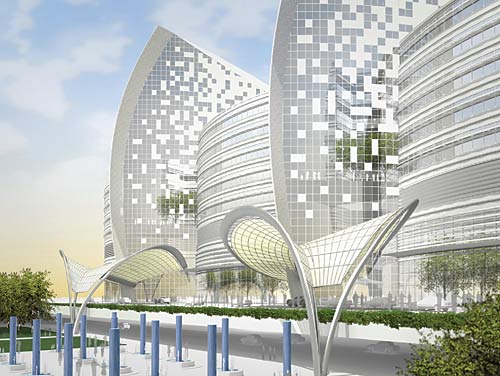The New Age of High-Tech Hospitals
Learning Objectives:
- Describe changes in technology that will affect hospital design.
- Explain the advantages of converging networks onto fiber-optic cable.
- Discuss the IEEE standards that will promote convergence.
Credits:
The best new digitally enabled American hospital of the next five years may be in Qatar. This tiny Middle Eastern state has brought together American architects Ellerbe Becket and Pelli Clarke Pelli to design the technologically advanced Sidra Medical and Research Center, part of the ambitious Education City project in Qatar's capital of Doha.
If built as planned, Sidra would epitomize a fairly progressive model of acute-care hospital design, where architects and their clients deploy technology in a variety of modes: in the realm of patient care; for enabling international collaboration and education in the medical field; to operate building systems; and to design the building itself. Perhaps most explicitly, technology could be used as a way to explain the hospital and its spaces to visitors. But what all of these disparate applications may ultimately share is a single digital conduit-or backbone-that collapses the information technology (IT) supporting the processes of running a hospital onto a piece of fiber-optic cable.
"Before, each system had its own cabling infrastructure, while now that's no longer the case," says Joe Leger, a Seattle-based principal with EDI, a group of information-technology consultants based in Atlanta who specialize in health-care technology. "When we ask for large rooms for IT, architects cringe, but we're actually saving space because traditionally we would have been asking for individual rooms for each system." Leger is consulting with Ellerbe and Pelli on the nearly 400-patient-bed, 1.7-million-square-foot Sidra project. The hospital-Sidra is the name of an indigenous tree in Qatar-will be operationally connected to the Weill Cornell Medical Center in New York City.
Nowhere has convergence caught on more than in the operating room (OR) suites, where the past five years have seen an explosion in the use of flat-screen monitors, interventional radiology equipment, and videoconferencing capabilities that have brought such heretofore invisible support equipment, like IT racks and cabling wireways, into a realm previously considered sacrosanct for reasons of hygiene.
Â
Â
|
Contrary to this development, however, the emergence of the IT consultant as a major player at the health-care design table continues slowly, with many consultants still lamenting that by the time architects include them in the process, it's often too late. Furthermore, the health-care industry, and its architects, increasingly grapple with a variety of digital-infrastructure issues, such as myriad cable options and space planning, that have yet to be codified. But industry players see change on the horizon.










